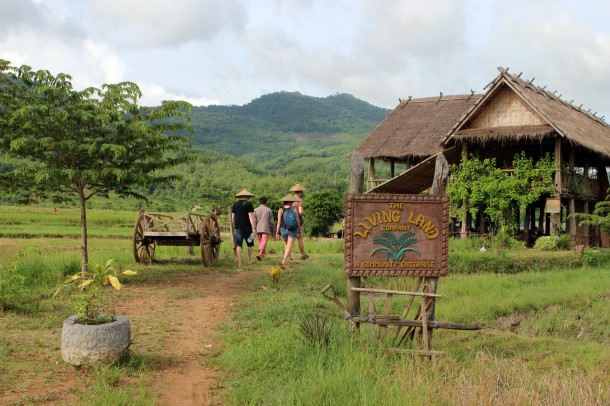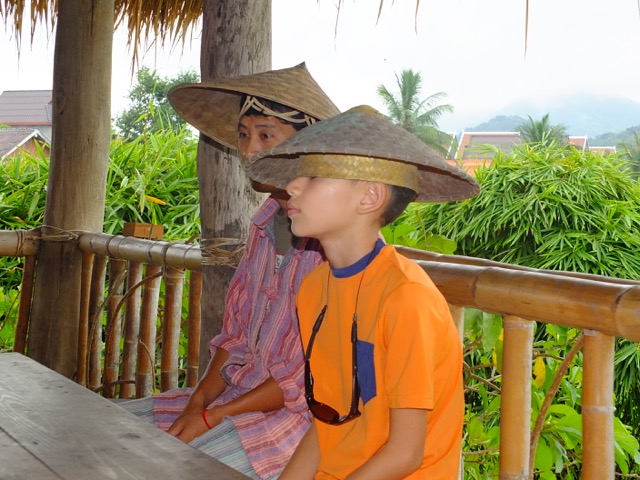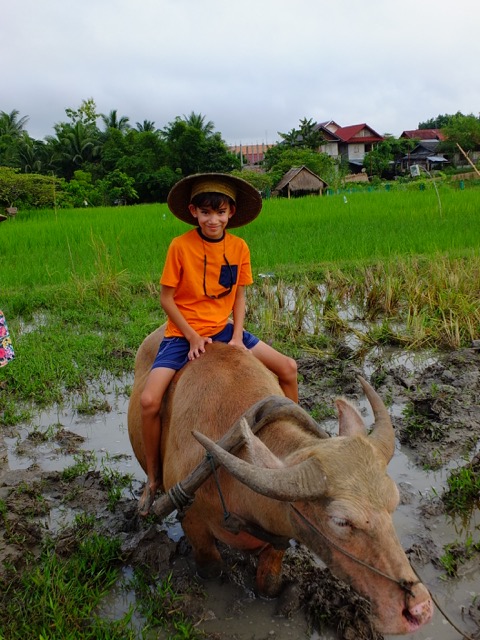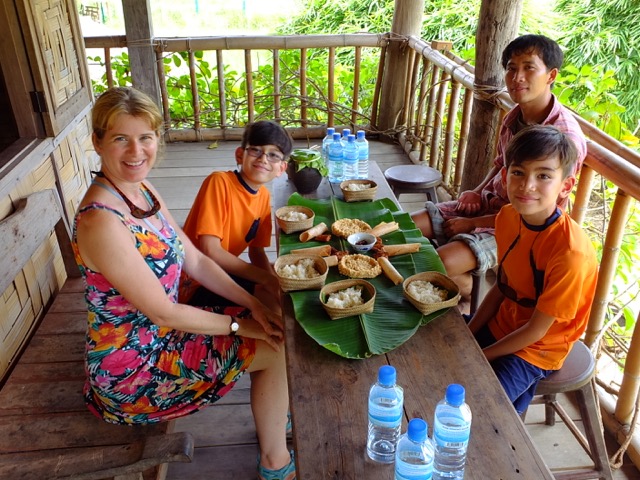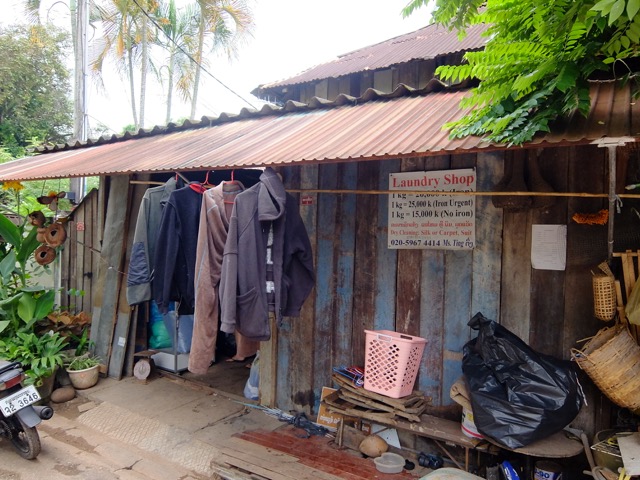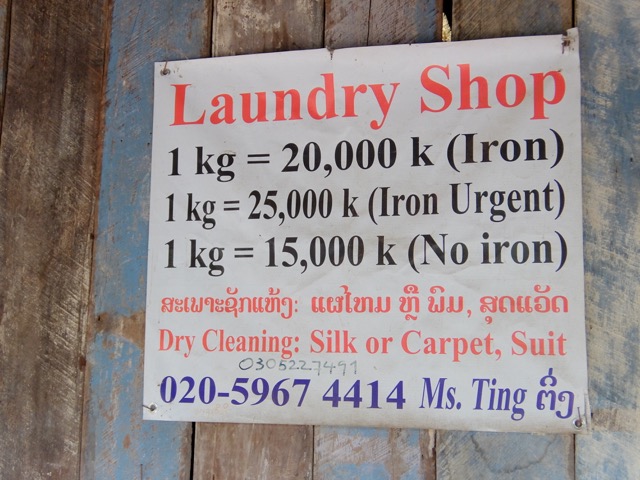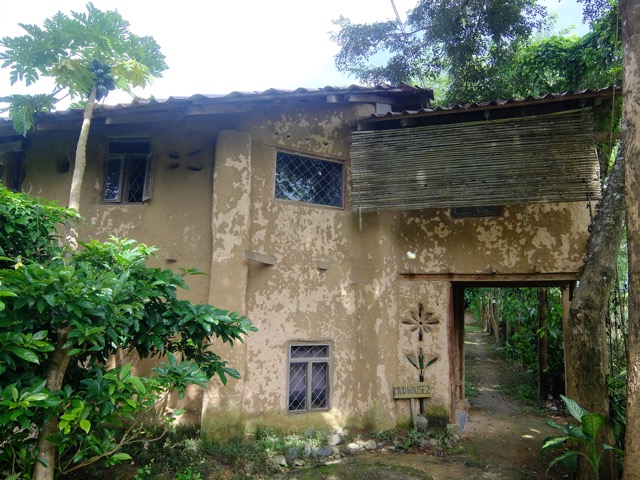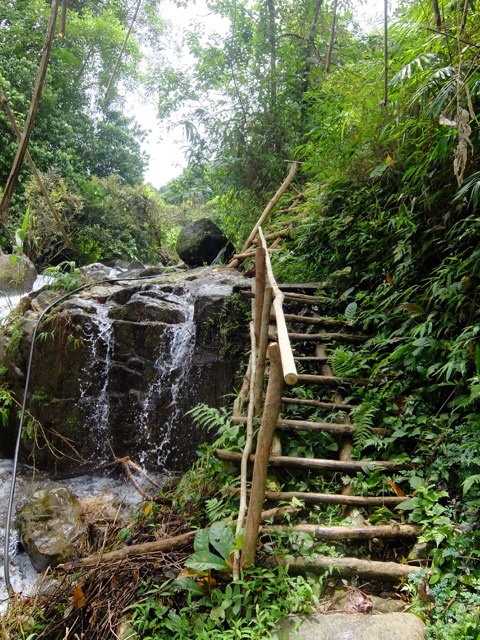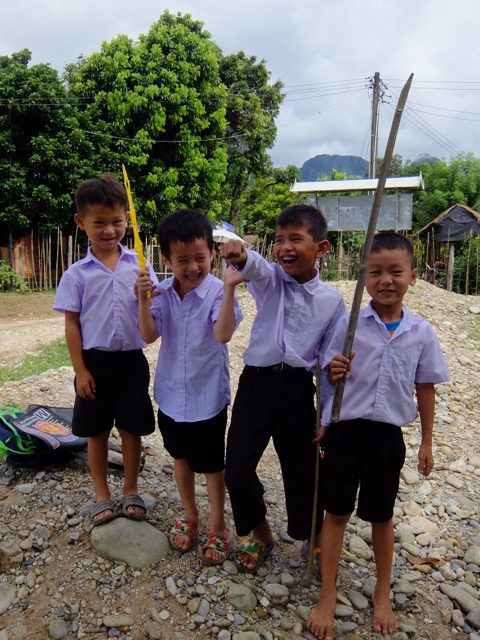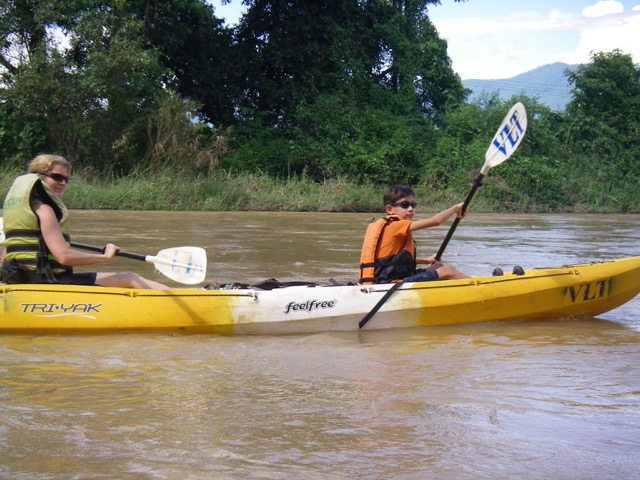When it’s time for us to travel between cities in Laos, we can just never be sure what kind of a bus adventure we are in for! Our very first bus ride in Laos, from Vientiene to Vang Vi eng, we lucked out and got a nice VIP bus. Although we had to cram onto a far-too-small tuk tuk, with all of our heavy luggage, to get to the bus, once we arrived we boarded a modern-looking, air conditioned bus, not unlike a Greyhound bus back in Canada. Yes, we did have to wait about an hour while they figured out what to do with the extra passengers since they had over-filled the bus (they ended up putting some in a minivan) but all in all, it was a pretty uneventful experience. Caleb, and I get motion sickness but fortunately the road to Vang Vieng is so bad, with ruts and potholes that the bus can’t go over 40 km/hour. Between that, and having to wait for herds of cows to clear the road, the bus didn’t go fast enough for us to worry about any nausea!
eng, we lucked out and got a nice VIP bus. Although we had to cram onto a far-too-small tuk tuk, with all of our heavy luggage, to get to the bus, once we arrived we boarded a modern-looking, air conditioned bus, not unlike a Greyhound bus back in Canada. Yes, we did have to wait about an hour while they figured out what to do with the extra passengers since they had over-filled the bus (they ended up putting some in a minivan) but all in all, it was a pretty uneventful experience. Caleb, and I get motion sickness but fortunately the road to Vang Vieng is so bad, with ruts and potholes that the bus can’t go over 40 km/hour. Between that, and having to wait for herds of cows to clear the road, the bus didn’t go fast enough for us to worry about any nausea!
Our bus ride from Vang Vieng to Luang Prabang was a slightly different experience, as you may recall from Clay’s blog. What you must realize, however, is that since Clay is the only one of us who doesn’t suffer from any motion sickness, a bus ride for him generally means finding a seat near the back of the bus and settling in to read his book or falling off to sleep (which he can do almost instantaneously) and therefore I would not consider him a reliable source when recounting the details of our bus adventures! Let me give you the full account below.
I had done the research on buses from Vang Vieng to Luang Prabang (yes, I am the researcher and organizer for this trip!) and knew that it was going to be long and painful. Every book I read mentioned that you should take motion sickness medication for the ride if you have ever had any issues with car-sickness at all. Also, the ride took 7-8 hours: this could feel like a lifetime if it is spent with your head in a sick bag.
Anyway, I had prepared for the trip: we had collected sick bags from various sources (double lined grocery sacks, bags from the backs of our airplane seats, etc). We purchased a few anti-nausea snacks (Ritz crackers: yes, we found some at the mini grocer!). We ate a “keep it down” breakfast of baguette, yogurt and muesli. And Caleb and I took anti-nausea medication.
But just as we arrived at the depot to get the tickets, two tourists spoke to Clay about how much better it was to take the minibus than the big bus – because apparently it swayed much less from side to side going around the many curves.
Word of advice: BE CAUTIOUS WHEN TAKING THE ADVICE OF OTHERS!
So, needless to say we bought tickets for the minibus. They were quite a bit cheaper than the VIP bus (which did make me wonder!!). We waited on the street for the bus to show up, and up pulled a nice little minivan, with tinted windows and air conditioning. “Ah, this will be better!” I thought. “Not your bus,” said the lady who had sold us the tickets. “Oh dear,” not a good sign!
Instead, a few minutes later a truck pulled up and we were told to climb in the back because, “Take you to your bus” the lady remarked. Off we went, with an all too familiar feeling that we would be cramming this truck to the brim with travelers and their bags. Sure enough we drove around until we were packed full and then pulled into a gas station where a man told us to get out.
This is where we went wrong! We are so used to trying to teach the boys to be considerate of others that we didn’t jump out of the truck and run to the waiting mini-vehicle-thing and try to get seats together near the front. Instead we helped people out with their heavy bags and Clay stayed to hoist the big bags onto the top of our new mode of transportation.
When we finally looked in to get our seats, the bus/van was nearly full. Clay and Caleb took 2 seats near the back (because we didn’t think Connor suffered from motion sickness at this point!). Caleb managed to get a seat by the side door and I sat in the row in front of him with two Korean gentlemen. Already the van was full – with 13 of us and backpacks squished between our knees and the seats. Off we went and I double-checked that the sick bags were within arms reach.
We had only traveled 3 or 4 km down the road when the van pulled over to pick up a Lao woman with her bag. People in the front row moved over to make space and off we went again. I was happy at this point, that the road was still very bad and there were lots of cattle in our way, meaning we couldn’t travel at high speeds – which is always better for motion sickness.
After about an hour, we stopped again at the side of the road. This time a little old woman and her husband, who looked like they were on their way to the market, climbed aboard. Since we were out of space on the seats, the driver managed to squeeze the couple’s large bag of rice on the floor beside Caleb and pointed to it for the woman to sit. She had a look of concern on her face but plopped down on the bag of rice and held on to the side of Caleb’s seat. The driver then proceeded to shove the front seat of the van as far forward into the windshield as he could, making things rather uncomfortable for the Korean girl and the local Lao woman sitting up front. This left a gap between the front seat and me, in the second row, where the driver pointed for the man to sit. There was no seat, just a ledge that I think could be used as a foot rest, but the man perched down on it, the door closed, and off we went again.
It was clear, within minutes, that both the man and woman struggled with motion sickness, and we were now getting into the mountains leaving the slow roads filled with cattle behind. The van started to swerve around corners and we all swerved with it. The little old lady started to moan and pulled out some tube of strong smelling cream that she held to her nostrils and which started to permeate the air in the van. The man, clearly uncomfortable on his footstool perch facing backwards, tried to turn and face the road by squatting, bum in the air, right in front of me, and holding on to the seat in front of him for dear life. This of course meant that he was holding the back of the seat of the poor Korean girl, who was already looking rather uncomfortable, and now had his arm resting against the back of her head!
The little old woman started to nod off and ended up falling over onto Caleb’s lap! Caleb didn’t say anything until we stopped for 5 minutes at an outhouse for a bathroom break at which time he expressed his displeasure at the whole situation!
When we climbed back in the van, I agreed to switch places with him and sat with the little old woman beside me. We started out again and it began to rain, at which point we discovered the van was not water tight. Water came in through the sliding door, dripping on us every time the van swayed from side to side.
By this point we’d had a few hours of swerving around the mountains and the nausea was setting in. I kept my eyes on the horizon and managed to feel OK the whole trip but Caleb and Connor used up our supply of sick bags, as did the little old woman who had her own stash.
Seven hours later we pulled in to Luang Prabang and clambered off the bus. Funny enough Caleb and Connor both said, “It wasn’t as bad as we thought it might be!” I guess our preparation had helped. We had warned them that the bus could be jammed full of people and animals (chickens, etc) as that wasn’t unheard of here. When we sat down to dinner we talked about the pluses of our bus ride, the minuses, and what we learned from it. Later that night I found the blog of a family who had recently travelled through Laos and they wrote about how, for a few extra dollars, you can hire your own minivan and take the “short cut” through the mountains, arriving in Luang Prabang in 3-4 hours. Live and learn!!!
The host of our guest house in Luang Prabang found it quite surprising that we’d arrived on the minibus, remarking that the VIP is so much better! So, when we needed to get bus tickets to travel to Syaburi we thought it best to ask his advice! He and his wife went to the station and purchased the tickets for us, reassuring us that we were traveling on the nicely air conditioned Thai bus. They suggested that as soon as we arrive in Syaburi we purchase the return ticket, for the next day, on the same kind of bus.
As they had told us, our bus to Syaburi was a big air conditioned bus, which was quite comfortable. With the ride being only 2 ½ hours, it was an absolute breeze compared to our previous trip!
When we arrived at the bus station (I use that term very loosely! Bus station = cement platform where you get on and off a bus and there is a ticket wicket nearby) Clay and I dutifully went to the ticket wicket to purchase the return tickets. “4 tickets to Luang Prabang on Thai bus for tomorrow”, we asked cheerfully. The man just looked at us with a confused expression on his face. “4 tickets, Luang Prabang”, we repeated. He took a piece of paper and wrote on the back 14/09/15. We shook our heads and wrote, 15/09/15. “Ahh!” he nodded and got his pad of tickets. He wrote 2 tickets and passed them to us. We pointed at the 2 boys sitting on the bench behind us and showed him 4 fingers. He nodded again and wrote 2 more tickets. “60,000” he said and showed 1 finger. Hmmmm the other tickets had been 90,000 each.
“This is bus from Thailand?” I asked him. More confused look.
“I think this is the only bus. We’d better take them.” I said to Clay. On the sign I noticed there was only one return bus to Luang Prabang at 2 pm. “Let’s just hope it’s the same bus.”
Fast forward 24 hours and we are pulling into the same “bus station”. There are two buses sitting there. A nice big modern one with air conditioning that looks like the one we arrived on and another less ‘refined’ one, that looked like a school bus that had had traveled through a war zone. Windows open, seats ripped, windshield cracked……..you know where this is going!
We asked, “Luang Prabang?” and pointed at the nice big fancy bus. The ticket man pointed over to the other bus and motioned for us to get on. “This might be a long ride,” Clay said as we headed to the dilapidated looking bus. Since the bus had been sitting there for a while, it was already nearly full so we had to make our way to the only empty seats near the very back of the bus. “Oh dear,” I thought! “Do you have the bags ready?” Clay asked.
A few other people got on and the bus set off. Clay promptly pulled out his book and started to read while I tried to perch myself on the edge of the seat such that I could see out the front window and watch the road ahead, hoping to fend off motion sickness. It was then that I noticed the large box in the middle of the aisle that we had climbed around, with a little farmer perched on top. Two rows in front of me in the aisle was a cage filled with rats or moles, I’m not sure which! Whichever they were, they were probably to be sold at the market that night.
Caleb and Connor closed their eyes and tried to sleep in an attempt to stop from getting sick. Again, after about 20 minutes we stopped to let more people on with their goods. Then, after about 1 ½ hours the bus stopped and the driver yelled something. “I think it’s a bathroom stop,” I said, when Clay looked at me. “But there is no bathroom,” he replied. We had parked beside a field with tall grass. Sure enough, as we watched 2/3 of the people on the bus jumped off and found a spot in the field. You could see them doing up their pants as they walked back toward the bus! After 2-3 minutes we set out again.
It was as the bus started off again that both Caleb and Connor remarked, “We don’t feel sick!” I had to agree. With the windows all wide open and the wind blowing in, we didn’t feel car sick at all! True, when we traveled through areas of the countryside where the farmers were burning the fields, it filled the bus with smoke, but it actually felt good to have the air circulating through the bus. Also, there was no fancy curtain covering the front windshield, which they put in the big buses to shade you from the sun; so you could actually see the road ahead.
We arrived in Luang Prabang punctually, 2 ½ hours later and we all agreed, “You can’t judge a bus by its cover!”
 Conservation Centre in Sayabouri, 3 hours from Luang Prabang. After a bus ride, followed by a short boat ride across the lake, we arrived at the centre.
Conservation Centre in Sayabouri, 3 hours from Luang Prabang. After a bus ride, followed by a short boat ride across the lake, we arrived at the centre.


 and forth because this is how she stays cool and circulates its blood. Elephants should only be ridden for short periods (3 hours or so) because they nee
and forth because this is how she stays cool and circulates its blood. Elephants should only be ridden for short periods (3 hours or so) because they nee d to rest and eat.
d to rest and eat. but stop and sleep for a few minutes and then continue eating. When they sleep, their ears droop and stop moving but when they wake they start moving their ears again. We also saw the elephant garden, which was a large area in the jungle filled with different kinds of trees and grasses.
but stop and sleep for a few minutes and then continue eating. When they sleep, their ears droop and stop moving but when they wake they start moving their ears again. We also saw the elephant garden, which was a large area in the jungle filled with different kinds of trees and grasses. old baby elephant with her mother. Elephants weigh about 150 kg when they are born. They can stand up right away. Their mothers teach them how to swim and eat. Elephants stay in their mother’s tummy for about 22 months – a long time! They drink their mother’s milk for 2-3 years but they can begin eating small pieces of sugar cane from about 8 months.
old baby elephant with her mother. Elephants weigh about 150 kg when they are born. They can stand up right away. Their mothers teach them how to swim and eat. Elephants stay in their mother’s tummy for about 22 months – a long time! They drink their mother’s milk for 2-3 years but they can begin eating small pieces of sugar cane from about 8 months. wed us the target training they do to prepare the elephants should they ever need shots and medication. For the target training the elephant is brought into a wooden enclosure and is
wed us the target training they do to prepare the elephants should they ever need shots and medication. For the target training the elephant is brought into a wooden enclosure and is  fed treats every time she does what the veterinarian asks. For example, “foot up”.
fed treats every time she does what the veterinarian asks. For example, “foot up”.





